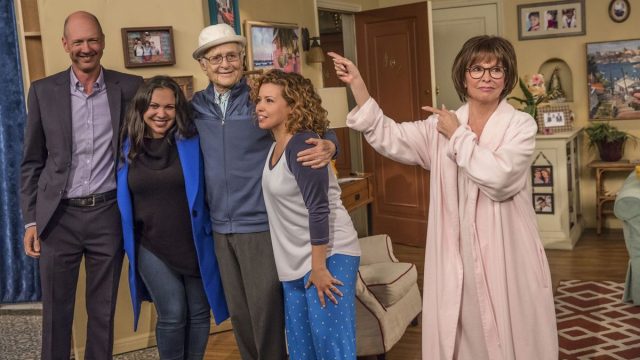Are we in “Peak TV?” Have we passed that peak or is the best yet to come? Who knows, honestly. What is pretty clear is that most of the narrative around “Peak TV” has followed a pretty linear progression from The Shield –> The Sopranos –> Mad Men and Breaking Bad, and Then Maybe Some Sci-Fi Shows and Stuff About Dragons. Our cultural narratives, which prize dark dramas over silly fun and manly men and tough women over fun, hope and bright colors, don’t always recognize that it’s not just the Serious Dramas that are doing great work. Sitcoms often get lost in the mix. Sometimes a Parks & Rec or Arrested Development will break through enough to get critical attention, but often it’s prefaced some kind of apology, with the clarification that the show in question is ‘not JUST a sitcom,’ and usually they’re some kind of genre-breaking or high concept show (think of Arrested Development, It’s Always Sunny in Philadelphia, or The Good Place).
But JUST a sitcom is, sometimes, more than enough. Lori Loughlin wouldn’t be in the headlines right now if her (never terribly good) show Full House and its revival Fuller House hadn’t meant been watched for so long by so many. When Katherine Helmond passed away earlier this month, she was remembered as much (if not more) for Soap and Who’s the Boss? as she was for her incredible work in Brazil. We may invite Saul or Tony Soprano into our homes for an hour or so a week, but they’re not our friends. But sitcom stars? They’re single moms or working class stiffs or office drones hoping for something more. They rarely have superpowers, though sometimes their incomes or apartments may seem a bit out of this world. They’re made to be relatable in a way that many drama stars are not. They’re family. They’re us. I think that’s one of the reasons sitcoms have had to struggle to get critical recognition; they’re ‘small’ stories, and the critic’s eye is so often drawn to the big and grandiose and over-the-top.
These ‘small’ stories often center women. Full House began as the story of three men and their children, but the breakout celebrities were mostly women, including the Olsen twins, who were the faces of a small empire of direct-to-video specials and other film and TV appearances before becoming the faces of a fashion empire. In the 80s, Designing Women and The Golden Girls, both focused strongly on female friendship, were powerhouse shows. Murphy Brown had so much cachet the Vice-President complained about her. Even as the 3-camera sitcom began to falter, women often drove the storylines on sitcoms, from Veep and Parks and Recreation to 30 Rock. And the 3-camera sitcom never went away: it lived on Nickleodeon (most successfully in iCarly and its immediate spinoffs) and The Disney Channel for tweens (launching, among others, Zendaya and Olivia Holt) and lumbered on in prime time, in shows that were critical failures and commercial successes (Last Man Standing, Two Broke Girls, The Big Bang Theory).
The 3-camera sitcom has made a bit of a critical comeback in recent years. Anna Faris and Allison Janney’s Mom has flown past 100 episodes and will run into the 2020s. 2019-20 brought us The Connors, the retooled Roseanne reboot, now firmly focused on Sara Gilbert’s Darlene, and…Murphy Brown. And over on Netflix, Norman Lear’s reboot of his 70s hit One Day at a Time, has had three solid seasons, before yesterday’s abrupt cancellation.
As many better critics have pointed out before me, it’s hard to say how many viewers is ‘not enough viewers’ for Netflix, and it’s always been my opinion that Netflix does a pretty terrible job of promoting its own stuff. I’m not going to bother to get into the weeds on this; I’ll just note that the Twitter hashtag is #SaveODAAT and I do have a Hulu subscription and access to the major networks.
So instead, I’m going to talk about how One Day at a Time, in addition to being a phenomenal critical success, is genius both at using the three-camera format and at making the specific universal. Most of the show is set in the Alvarez family home, where Penelope, a single mom, nurse, and military veteran, lives with her two children and mother (the always-delightful EGOT winner Rita Moreno). There are episodes that never leave the living room, including a tour de force bottle episode early in the series where Penelope is stuck on hold with the VA (and is, as a result, chained to her landline). This Vulture piece gets into how well the show uses the familiar setting of a family living room, the Alvarez family couch often in the center of the frame, to make its highly specific stories feel universal and relevant. It’s great, but it misses the singular pleasures of the way the show uses Rita Moreno’s entrances as act break, joke or dramatic revelation as the plot requires, or the fact that the live audience (not a laugh track, and in fact the bloopers the show has shared indicate that sometimes the reactions get toned down in the final product) is less a forced intrusion and more of a tool to make watching the show feel even more communal.
And it is astonishingly communal. Norman Lear produced this show, and Norman Lear has probably not produced a show in his career that didn’t touch on at least one political issue at least once. This means that One Day at a Time was not afraid to touch on some of the hot-button issues of the twenty-teens. If and when you wander over to the #SaveODAAT tag, you’ll see people talking about representation, about seeing their lives on screen for the first time. And I’m there, too, seeing myself in Penelope Alvarez.
Here’s what I’m not: a military vet, Cuban-American, a nurse, a teenager, a grandmother, a mother of two, a renter in a tight housing market on the West Coast. Here’s what I am: a single mother whose relationship with her ex is not always easy or straightforward, who sometimes struggles to balance the needs of the generation ahead of her with those of the generation that will follow her. Who cries when she has to let go of the half-broken used car that’s just not safe to drive in any more. Who sometimes puts her own health last because everyone else needs you more. Who’s thought ‘I should be stronger’ or ‘I’m not sure how I’m going to handle this.’ When I watch this show, I see me, more clearly than I do sometimes when I look in the mirror.
Whoever you are, you’re on screen in One Day at a Time. Maybe it’s when you worried how your mother would handle it when your kid came out. Maybe you’re the kid coming out. Maybe you’re the nurse who’s given up her dream of becoming a doctor and wondering if it’s not too late after all, or the guy with his hand around his eight-year chip. Maybe you’re the teenager who just got busted for your vape pen, or the grandmother worried that your family is losing its relationship with God. It’s all there, and it’s all so, so familiar, even if no one in your family knows a word of Spanish. Even if your own mother couldn’t find Cuba on a map.
And it does it without a single moment of apology. Rita Moreno speaks Spanish, and it’s often untranslated. The Alvarez daughter, Elena, identifies as a lesbian and gains a love interest as the show goes on. Penelope’s support group of women veterans grows to include, without comment, multiple women of color, a wheelchair user, and a character portrayed by multiracial transfemme genderqueer actor Nicky Endres, who gets some of the best zingers in the third season. (The group is led by sexual assault survivor–and star of the original One Day at a Time–Mackenzie Phillips.) The show takes diversity as a given, and is much richer for it.
This trick–of finding the universal, human truth in a specific, rooted experience–is one of the simplest and most profound tricks of storytelling. And that it is simple does not, in any way, make it easy. But One Day at a Time makes it look easy, effortless, opening up the world of a Cuban-American family and letting us sit on the couch and make ourselves at home. It’s an honor to have been there. I hope I can visit again.
Other people have had many, many eloquent things to say about this show, but I’ll leave you with one: Stephanie Beatriz’s Twitter thread about her experiences on the set in Season 3.


